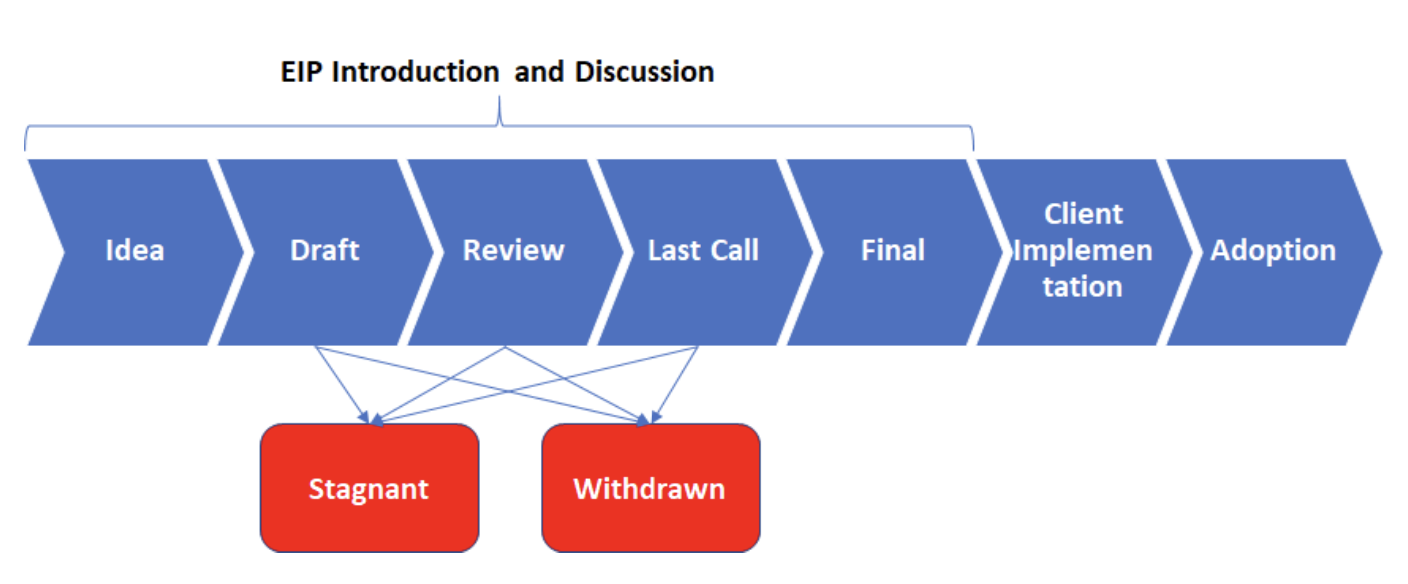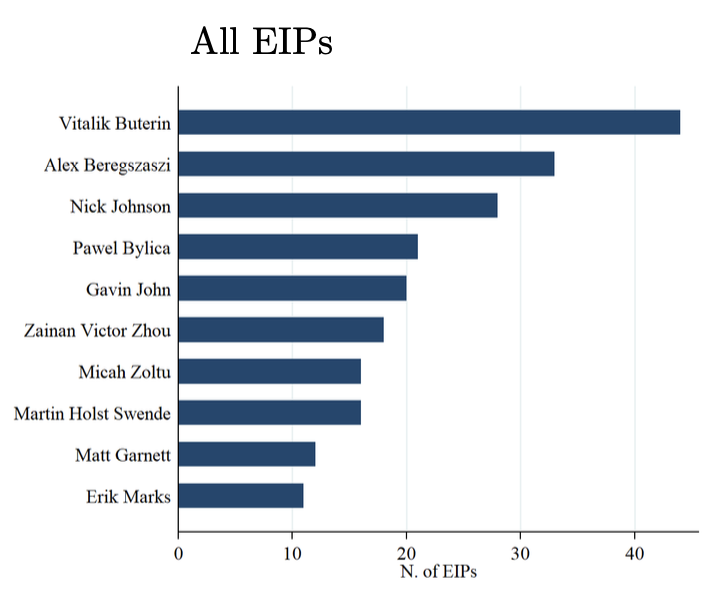Ethereum is a pioneering force, representing the largest blockchain by market capitalization after Bitcoin. The Ethereum Foundation is driving innovation in decentralized applications and smart contracts. Behind its technological marvels lies a governance framework that shapes its role in the market.
In a thorough analysis of the governance structure of the Ethereum blockchain, Fabian Schär and co-authors offer insights focusing on three critical facets: transparency, decentralized decision-making, and the link between governance decisions and token prices. It was found that a group of 10 people are responsible for 68% of the implemented Ethereum Improvement Proposals (EIPs). Is this still a decentralized model or a system of concentrated power? CVJ.CH reviewed the 46-pages research paper that highlights both Ethereum's strengths and weaknesses, and sheds light on the factors that will determine its trajectory in the crypto sphere.
What is the Ethereum blockchain?
Ethereum had its initial coin offering (ICO) in 2014 and launched in 2015. Today, it is a pioneering blockchain platform known for its versatility beyond just cryptocurrency. Unlike Bitcoin, Ethereum supports the execution of smart contracts and decentralized applications (dApps). Ethereum operates on the Proof of Stake (PoS) consensus mechanism through a network of nodes, eliminating the need for centralized control and enabling transparent, tamper-resistant transactions. Ether (ETH), Ethereum's native cryptocurrency, fuels this ecosystem, serving as both a medium of exchange and a means of incentivizing network participants. Ethereum's groundbreaking introduction of smart contracts has revolutionized multiple industries by automating agreements and transactions without relying on intermediaries.
The Ethereum ecosystem has since fostered a vibrant community of developers and innovators. With its open source nature, Ethereum encourages collaboration and experimentation, leading to the creation of diverse applications ranging from decentralized finance (DeFi), gaming, governance of decentralized autonomous organizations (DAOs), and NFTs. As a result, Ethereum has emerged as a cornerstone of the blockchain landscape, driving innovation and serving as a catalyst for decentralized solutions. However, the question raised in the reviewed research paper is whether the system can still be considered decentralized when the key developments are driven by a small group of individuals.
Openness and transparency of Ethereum
In the landscape of blockchain, the concept of transparency stands out as a critical aspect. It is one of the principles deeply embedded in open source communities worldwide and in the Bitcoin ethos that gave birth to Ethereum. This principle is not only a functional necessity, but is also upheld as a cultural value, based on the belief that openness facilitates collaboration and produces positive results. Focusing on Ethereum's governance processes, three key measures - the availability and technicality of the Ethereum protocol documents and codes, the anonymity of participants, and the transparency of the Ethereum Foundation.
A fundamental belief of cryptocurrency communities is that "code is law". Therefore, understanding the technical documentation and code associated with transactions is essential. However, this poses a challenge for those who lack technical expertise. To assess the readability of Ethereum Improvement Proposals (EIPs), their length and readability were analyzed using the Flesch Reading Ease scale. The results indicate that a college-level understanding is typically required, which is expected for technical documents. However, efforts to improve the clarity of EIPs could improve accessibility for a wider audience.
In contrast to the prevalence of anonymity in the cryptocurrency industry, which is often associated with fraudulent activities such as fraud, most Ethereum contributors disclose their identity. They do so even though there is no formal requirement. 89% of contributors and 79% of the most prolific client developers disclose their full names. In addition, these disclosed contributors are actively engaged on social media platforms such as X (formerly Twitter) or Linkedin. Overall, the level of transparency in Ethereum's governance is exceptional and stands in stark contrast to governance models found in traditional public or private companies.
EIPs: How changes are made on the Ethereum
Ethereum's Improvement Proposals serve as the backbone of Ethereum's development, allowing community members and developers to propose changes and enhancements to the Ethereum protocol. These proposals cover a wide range of improvements, including changes to the core protocol, client software, and standards for decentralized applications (dApps) and smart contracts. EIPs are categorized into six different types, depending on their area of proposal. EIPs undergo a rigorous review process that includes discussions among developers and community members to determine their acceptance, rejection, or deferral.
EIP process from idea generation to adoption / Source: Research paper "Decentralized Crypto Governance?"
The process begins with idea generation and discussion on platforms like the Ethereum Research Forum. Proposals progress through draft, review, and final call phases, guided by principles of rough consensus rather than formal voting. The EIP process (see image below) includes three main phases. EIP introduction & discussion, implementation, and adoption. Once finalized, EIPs are implemented by Ethereum clients. The clients are maintained by dedicated development teams working with EIP authors. EIPs are prioritized based on available resources and community feedback. After implementation, node operators decide whether to adopt the changes.
The role of the Ethereum Foundation
The Ethereum Foundation is a non-profit organization based in Zug, Switzerland, which is dedicated to supporting the development and advancement of the Ethereum blockchain. It was established in 2014 by Ethereum co-founder, Vitalik Buterin, and several other key individuals involved in the project. The foundation's primary goal is to fund research, development, and educational initiatives that contribute to the growth and improvement of the Ethereum ecosystem. As such, it plays an important role in coordinating Ethereum's development roadmap, funding core protocol development, supporting community projects and promoting adoption of the platform.
The Foundation has a three-member board of directors and publicly discloses its funding sources and addresses, which are accessible for real-time monitoring. Despite this transparency, the Foundation's operational approach differs from conventional practices, with limited reliance on traditional disclosure methods such as financial and audit reports. Instead, it leverages the inherent transparency of blockchain technology, which enables visibility into grants and transactions. Nonetheless, the foundation's governance processes appear less structured compared to traditional entities, with its first financial report not being published until 2022.
The Ethereum Foundation has wielded considerable influence in both the production of the EIP and the development of clients. Initially pivotal in the protocol's early stages, the Foundation's involvement in EIPs has however declined over time, particularly in token standard (ERC) EIPs. However, its involvement in core EIPs has steadily increased since 2019 and now accounts for over 40% of such proposals. It is worth noting that the data suggests that if EIPs are associated with the Ethereum Foundation, this does not mean that the proposal is more likely to succeed.
A breakdown of the EIP authors
A notable concentration of EIP production can be observed among a select group of individuals. Particularly, concerning significant EIPs that propose major changes to the protocol. The most influential authors were identified as Gavin John, Vitalik Buterin, Nick Johnson, Fabian Vogelsteller, and Charles Cooper. Their centrality underscores their significant contributions to EIP production. The concentration of these core contributors has persisted relatively unchanged over the past five years. Additionally, a small number of authors occupying central positions within the co-authorship network were identified. This finding goes against recent trends indicating a gradual decentralization of the network itself.
Top 10 authors ranked by number of co-authored EIPs / Source: Research paper "Decentralized Crypto Governance?"
Even though the major EIPs typically originate from a select group, there is still a larger community involvement and discussion. For example, EIPs can be commented on GitHub or, more popularly, in the AllCoreDevs Meeting. These bi-weekly calls include authors, contributors, and client developers, and are dedicated to core EIPs due to their technical complexity. They play a critical role in refining and ultimately finalizing EIPs for client implementation. Data suggests that authors actively prepare for these meetings. It also seems that their proposals are modified in response to feedback from the developer community.
Impact of governance on ETHs token value
Ethereum's governance structure differs from other cryptocurrencies. It allows participation in discussions regardless of Ether ownership. This is in stark contrast to traditional shareholder-based governance systems. Examining Ether's price trends around the final discussions of successful core EIPs reveals a significant price spike approximately 30 trading days prior. This demonstrates somewhat of a tangible impact of Ethereum governance on Ether's value. Wth prices increasing by an average of 12% in the days leading to EIP approvals.
But analyzing the actual influence of Ethereum's governance on the price of Ether faces two main challenges. First, selecting an appropriate benchmark for price comparison. This proves difficult due to Ether's significant outperformance of traditional markets such as the S&P 500 index. The comparison results in an upward drift in Ether's cumulative returns. Using Bitcoin as a benchmark mitigates this drift. However, the interconnectedness of the cryptocurrency market risks underestimating governance-related price reactions due to spillovers from Ethereum's performance to Bitcoin or altcoins. Second, Ethereum's transparent governance process. The process is characterized by gradual announcements and extensive public discussion. This complicates the assessment of governance-related price effects, as proposals are openly discussed and updated. Such an approach results in gradual price adjustments until finalization.
In conclusion
The thorough analysis exemplifies that Ethereum's governance structure plays a significant role on key aspects. Particularly, in handing in and concluding proposals as well as the native currencies' performance. Research suggests a correlation between the period leading up to EIP implementation and changes in market value. This underscores the significance of Ethereum's governance structure in influencing market dynamics.
The concentration of EIPs among a small group of individuals raised concerns about the decentralized nature of the platform. It suggests a potential centralization of decision-making power. However, the Ethereum ecosystem maintains a level of decentralization through the active participation of a broader community. The community is involved in the entire discussion and decision-making processe. Platforms like GitHub and developer meetings support open dialogue and collaboration. This ensures that diverse perspectives are taken into account and the decentralized ethos is adhered to.






